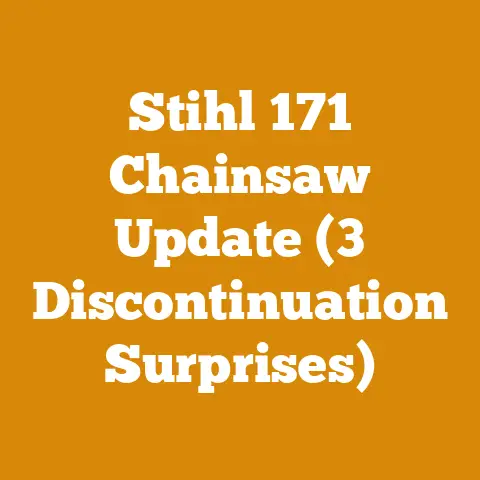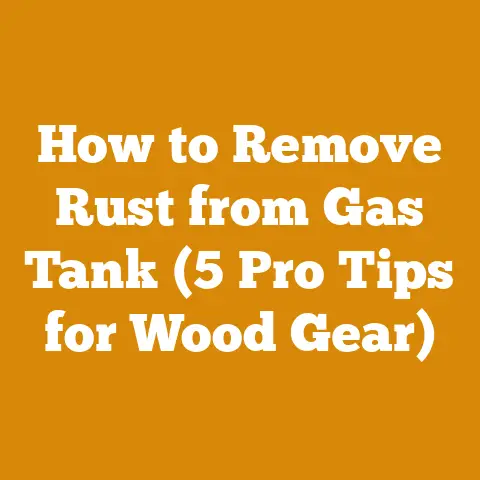Bucket Truck Insurance Tips (5 Pro Insights for Arborists)
Don’t Gamble With Your Business: 5 Bucket Truck Insurance Tips Every Arborist Needs Now!
Every time that bucket truck’s engine roars to life, you’re not just heading to a job; you’re putting your livelihood – and potentially everything you own – on the line. I’ve seen firsthand what happens when a simple misstep turns into a financial catastrophe. One slip, one unexpected branch fall, and suddenly you’re facing a lawsuit that could bury you faster than you can say “liability.” That’s why I’m laying out the five absolutely essential bucket truck insurance tips that can be the difference between thriving and just surviving.
I’ve been in the wood processing and tree care industry for over 20 years. I’ve seen it all, from small-time firewood hustlers to large-scale logging operations. I’ve learned a few things the hard way, and believe me, insurance is one area where cutting corners is a recipe for disaster. I remember a time when a fellow arborist, let’s call him Mark, thought he was saving money by skimping on his insurance. A freak accident involving a power line and his bucket truck left him not only injured but facing a mountain of legal bills. He lost his business, his truck, and almost his house. That’s a reality check nobody wants.
This isn’t just about ticking boxes on a compliance form; it’s about protecting your family, your employees, and the business you’ve poured your blood, sweat, and tears into. So, buckle up, because we’re diving deep into the insurance world, and I’m going to give you the insider knowledge you need to make informed decisions that can save your bacon.
Understanding the Risks: Why Bucket Truck Insurance is Non-Negotiable
Before we get into the tips, let’s be brutally honest: bucket truck work is inherently dangerous. You’re dealing with heights, heavy equipment, power lines, and unpredictable environments. The potential for accidents is sky-high (pun intended!).
Consider these sobering statistics:
- Fatalities: According to the Tree Care Industry Association (TCIA), falls from heights are a leading cause of fatalities in the tree care industry. Bucket trucks are often involved in these incidents.
- Injuries: Non-fatal injuries are even more common. These can range from minor cuts and bruises to severe fractures and head trauma.
- Property Damage: Bucket trucks can cause significant damage to property if not operated correctly. This could include damage to buildings, vehicles, and landscaping.
- Liability Claims: A single lawsuit resulting from an accident involving a bucket truck can easily reach hundreds of thousands, or even millions, of dollars.
I remember once witnessing a near-miss when a branch unexpectedly snapped and swung a worker into a power line. Luckily, he was wearing the right safety gear, and the quick thinking of his crew prevented a tragedy. But it was a stark reminder of how quickly things can go wrong.
The reality is that you can’t eliminate all risks, no matter how careful you are. That’s where insurance comes in. It’s your safety net, your financial shield against the unexpected.
5 Pro Bucket Truck Insurance Tips for Arborists
Alright, let’s get down to brass tacks. Here are the five critical bucket truck insurance tips that every arborist needs to know:
1. Don’t Skimp on Liability Coverage: Go Beyond the Minimum
This is the cardinal rule of insurance. Liability coverage protects you if you’re found liable for causing bodily injury or property damage to someone else. This could include injuries to a homeowner, damage to a vehicle, or even damage to underground utilities.
The temptation is always there to save a few bucks by opting for the minimum liability coverage required by law. But that’s a false economy. Trust me, the minimum is rarely enough.
Why Minimum Coverage Isn’t Enough:
- Medical Costs: Medical bills can quickly escalate, especially in cases of serious injury.
- Legal Fees: Defending yourself in a lawsuit can be incredibly expensive, even if you ultimately win.
- Settlements: Settlements can be substantial, particularly if the injured party is unable to work or suffers permanent disability.
I always advise arborists to carry at least \$1 million in liability coverage, and preferably \$2 million or more, especially if you operate in a high-risk area or work on large commercial properties.
Data Point: A study by the Insurance Information Institute found that the average cost of a liability claim involving a commercial vehicle is over \$70,000. This figure doesn’t even include legal fees, which can easily double or triple the total cost.
My Personal Experience: I once had a situation where a branch fell and damaged a neighbor’s fence. Luckily, my liability coverage was sufficient to cover the cost of repairs, but if I had only carried the minimum coverage, I would have been paying out of pocket.
2. Workers’ Compensation: Protect Your Crew (and Yourself!)
If you have employees, workers’ compensation insurance is not just a good idea; it’s the law in most states. It covers medical expenses and lost wages for employees who are injured on the job.
But even if you’re a sole proprietor or work with independent contractors, workers’ compensation can still be a smart investment.
Why Workers’ Compensation is Essential:
- Legal Requirement: As mentioned, it’s often legally mandated. Failure to carry workers’ compensation can result in hefty fines and penalties.
- Employee Protection: It provides peace of mind for your employees, knowing that they’ll be taken care of if they get hurt.
- Liability Protection: It can protect you from lawsuits filed by employees who are injured on the job.
- Financial Protection: It can prevent you from having to pay out of pocket for medical expenses and lost wages.
Case Study: I know of a small tree service company that didn’t carry workers’ compensation. One of their employees suffered a serious back injury while lifting a heavy log. The company was forced to shut down because they couldn’t afford the medical bills and lost wages.
Unique Insight: Some insurance companies offer “ghost policies” for sole proprietors. These policies provide workers’ compensation coverage for the owner without requiring them to list themselves as an employee. This can be a cost-effective way to protect yourself.
3. Equipment Coverage: Don’t Let Your Truck Become a Liability
Your bucket truck is your bread and butter. If it’s damaged or stolen, you’re out of business until you can replace it. That’s why equipment coverage is so important.
There are two main types of equipment coverage:
- Physical Damage Coverage: This covers damage to your bucket truck caused by accidents, theft, vandalism, or natural disasters.
- Inland Marine Coverage: This covers damage to your tools and equipment while they’re being transported or stored off-site.
Why Equipment Coverage is a Must:
- Replacement Costs: Bucket trucks are expensive to replace, often costing tens of thousands of dollars.
- Repair Costs: Even minor repairs can be costly, especially if they involve specialized parts or labor.
- Downtime: If your truck is out of commission, you’re losing money. Equipment coverage can help you get back on the road quickly.
Actionable Tip: When choosing equipment coverage, make sure to select a policy that covers the full replacement cost of your bucket truck and equipment. Don’t settle for a policy that only covers the depreciated value.
Data Point: The average lifespan of a bucket truck is 10-15 years. Over that time, it’s likely to experience some type of damage or wear and tear.
4. Know Your Exclusions: Read the Fine Print
This is where things get tricky. Insurance policies are full of fine print, and it’s essential to understand what’s covered and what’s not.
Common exclusions in bucket truck insurance policies include:
- Wear and Tear: Damage caused by normal wear and tear is typically not covered.
- Improper Maintenance: Damage caused by improper maintenance or neglect may not be covered.
- Illegal Activities: Damage caused by illegal activities, such as drunk driving or drug use, is never covered.
- Unapproved Modifications: Modifications to your bucket truck that haven’t been approved by the insurance company may void your coverage.
- Working on Powerlines: Many policies specifically exclude damage or liability related to working within a certain distance of powerlines. You may need a specialized endorsement for this type of work.
Why Understanding Exclusions is Crucial:
- Avoid Surprises: You don’t want to find out that you’re not covered after an accident has already happened.
- Make Informed Decisions: Knowing the exclusions allows you to make informed decisions about your risk management strategies.
- Negotiate Coverage: In some cases, you may be able to negotiate with your insurance company to remove or modify certain exclusions.
My Pro Tip: Sit down with your insurance agent and go through your policy line by line. Ask questions about anything you don’t understand. It’s better to be over-informed than under-informed.
5. Shop Around and Compare Quotes: Don’t Settle for the First Offer
Just like with any other major purchase, it pays to shop around and compare quotes from multiple insurance companies. Don’t settle for the first offer you receive.
Why Comparing Quotes is Important:
- Price Differences: Insurance rates can vary significantly from one company to another.
- Coverage Options: Different companies may offer different coverage options and endorsements.
- Service Quality: Some companies provide better customer service and claims handling than others.
How to Compare Quotes Effectively:
- Get Multiple Quotes: Contact at least three or four different insurance companies.
- Provide Accurate Information: Be honest and accurate when providing information about your business and your risk profile.
- Compare Apples to Apples: Make sure you’re comparing the same coverage limits and deductibles.
- Read Reviews: Check online reviews to see what other arborists have to say about their experiences with different insurance companies.
- Consider an Independent Agent: An independent insurance agent can help you compare quotes from multiple companies and find the best coverage for your needs.
Real-World Example: I recently helped a friend who was starting a new tree service company. He got quotes from five different insurance companies, and the rates varied by as much as 50%. By shopping around, he was able to save thousands of dollars on his insurance premiums.
Data Point: According to a study by Consumer Reports, people who compare insurance quotes save an average of \$500 per year.
Beyond the Basics: Advanced Insurance Strategies for Arborists
Okay, we’ve covered the fundamentals. But if you really want to protect your business, you need to go beyond the basics and consider some advanced insurance strategies.
Umbrella Insurance: Extra Layer of Protection
Umbrella insurance provides an extra layer of liability coverage on top of your existing policies. It kicks in when your other policies have been exhausted.
Why Umbrella Insurance is Worth Considering:
- Large Lawsuits: It can protect you from large lawsuits that exceed your primary liability limits.
- Peace of Mind: It provides peace of mind knowing that you have an extra layer of protection.
- Affordable Coverage: Umbrella insurance is surprisingly affordable, often costing just a few hundred dollars per year.
Example: Let’s say you have \$1 million in liability coverage, and you’re sued for \$1.5 million. Your primary policy would cover the first \$1 million, and your umbrella policy would cover the remaining \$500,000.
Professional Liability Insurance (Errors and Omissions): Protect Your Advice
Professional liability insurance, also known as errors and omissions (E&O) insurance, protects you if you’re sued for providing negligent advice or services.
Why E&O Insurance is Important for Arborists:
- Expert Opinions: As an arborist, you’re often asked to provide expert opinions on tree health, safety, and value.
- Misdiagnosis: If you misdiagnose a tree problem and recommend the wrong treatment, you could be sued for damages.
- Property Damage: If your advice leads to property damage, you could be held liable.
Scenario: You advise a homeowner to remove a tree that you believe is diseased. However, the tree is actually healthy, and the homeowner sues you for the cost of replacing it. E&O insurance would cover your legal expenses and any damages you’re required to pay.
Pollution Liability Insurance: Environmental Protection
Pollution liability insurance covers damages caused by pollution or environmental contamination.
Why Arborists Need Pollution Liability Insurance:
- Herbicide and Pesticide Use: Arborists often use herbicides and pesticides to control pests and diseases. If these chemicals contaminate the soil or water, you could be held liable.
- Fuel Spills: Fuel spills from your bucket truck or other equipment can cause environmental damage.
- Tree Debris: Improper disposal of tree debris can lead to soil contamination and other environmental problems.
Insight: Even if you’re not directly responsible for the pollution, you could still be held liable if it occurs on your property or as a result of your operations.
Cyber Liability Insurance: Protecting Your Data
In today’s digital age, cyber liability insurance is becoming increasingly important for all businesses, including tree service companies. It covers damages resulting from data breaches, cyberattacks, and other cyber incidents.
Why Cyber Liability Insurance Matters:
- Customer Data: You likely collect and store customer data, such as names, addresses, and credit card numbers.
- Business Operations: Your business operations may rely on computers and networks.
- Reputation Damage: A cyberattack can damage your reputation and lead to lost business.
Example: Your computer system is hacked, and customer data is stolen. Cyber liability insurance would cover the costs of notifying customers, providing credit monitoring services, and defending against lawsuits.
Maintaining Your Insurance: Staying Compliant and Protected
Getting the right insurance is only half the battle. You also need to maintain your insurance and stay compliant with all applicable laws and regulations.
Regular Policy Reviews: Keep Your Coverage Up-to-Date
It’s essential to review your insurance policies at least once a year to make sure they’re still adequate for your needs.
What to Look for During a Policy Review:
Key Elements of a Safety Program:
- Training: Provide regular training to your employees on safe work practices.
- Equipment Maintenance: Maintain your bucket truck and other equipment in good working order.
- Personal Protective Equipment (PPE): Ensure that your employees wear appropriate PPE, such as hard hats, safety glasses, and gloves.
- Job Site Inspections: Conduct regular job site inspections to identify and correct potential hazards.
- Emergency Procedures: Develop and practice emergency procedures for dealing with accidents and injuries.
My Experience: I’ve seen firsthand how effective safety programs can be. Companies that prioritize safety tend to have fewer accidents and lower insurance costs.
Documentation: Keep Accurate Records
Maintaining accurate records is essential for both insurance and legal purposes.
Types of Records to Keep:
- Insurance Policies: Keep copies of all your insurance policies in a safe place.
- Safety Training Records: Document all safety training that your employees receive.
- Equipment Maintenance Records: Keep records of all maintenance and repairs performed on your bucket truck and other equipment.
- Accident Reports: Document all accidents and injuries that occur on the job.
- Contracts: Keep copies of all contracts with customers and subcontractors.
Why Documentation Matters:
- Claims Support: Accurate records can help you support your insurance claims.
- Legal Defense: Documentation can be used to defend against lawsuits.
- Compliance: Proper record-keeping can help you comply with all applicable laws and regulations.
Communicate with Your Insurer: Be Transparent and Proactive
Maintain open communication with your insurance company. Be transparent about your business operations and any changes that could affect your insurance needs.
When to Contact Your Insurer:
- Changes to Your Business: Notify your insurer of any changes to your business, such as adding new employees or expanding your operations.
- Accidents and Injuries: Report all accidents and injuries to your insurer promptly.
- Claims: File claims promptly and provide all necessary documentation.
- Questions and Concerns: Don’t hesitate to contact your insurer with any questions or concerns you may have.
Remember: Your insurance company is your partner in protecting your business. By working together, you can minimize your risks and ensure that you have the coverage you need.
Final Thoughts: Protecting Your Future
Bucket truck insurance is not just a cost of doing business; it’s an investment in your future. By following these tips, you can protect your business from financial ruin and ensure that you can continue to provide valuable services to your community.
I know that insurance can be confusing and overwhelming, but it’s worth taking the time to understand your options and make informed decisions. Don’t be afraid to ask questions, seek professional advice, and shop around for the best coverage.
Remember, your business is your livelihood. Protect it with the right insurance.
And finally, here’s one last piece of advice based on a lesson I learned the hard way: always double-check your policy details before you need them. I once assumed I had a specific type of coverage, only to find out after an incident that I didn’t. Don’t make the same mistake. Now, go out there, work safely, and protect what you’ve built!






